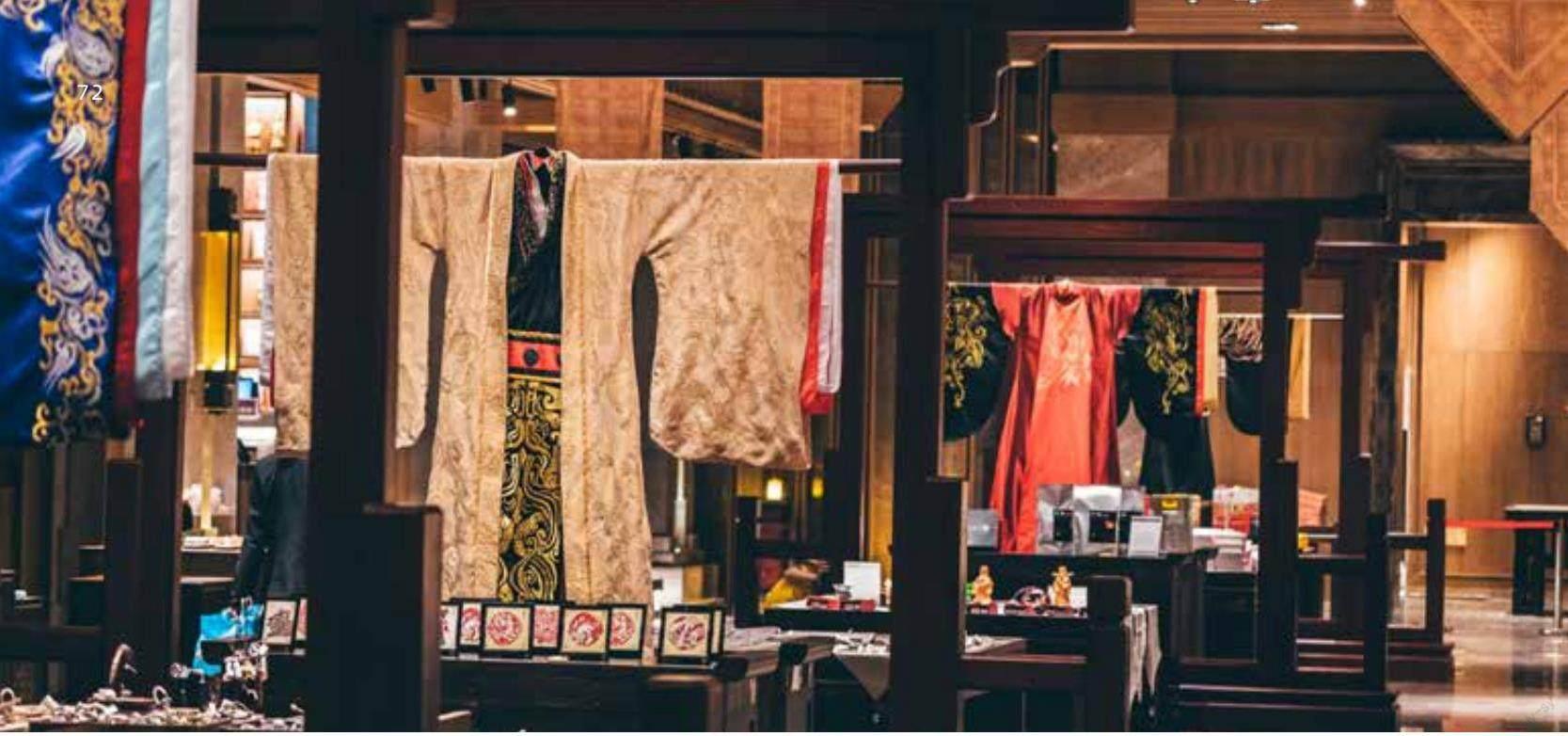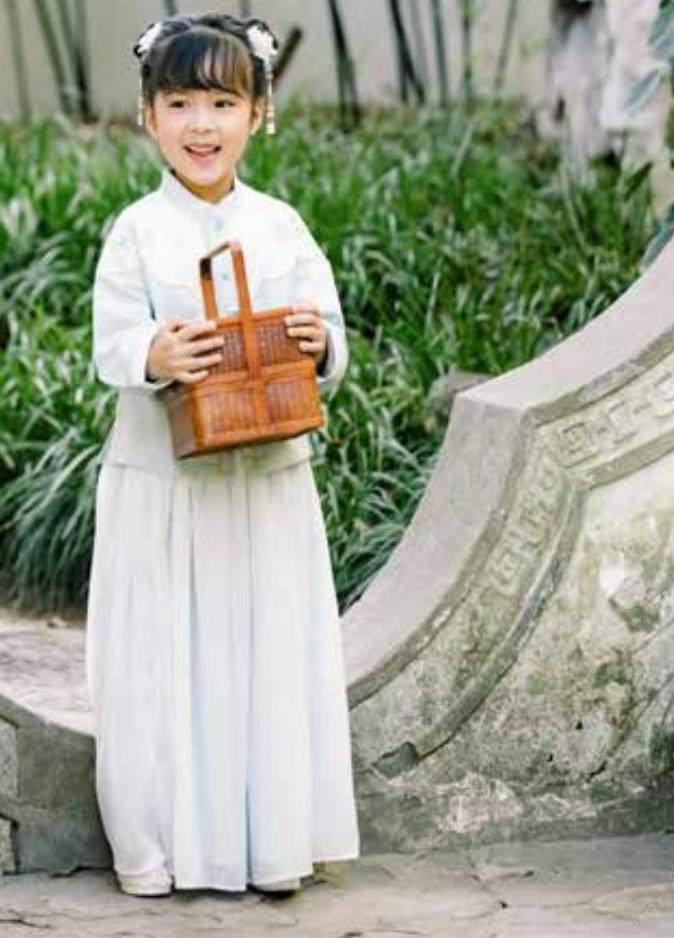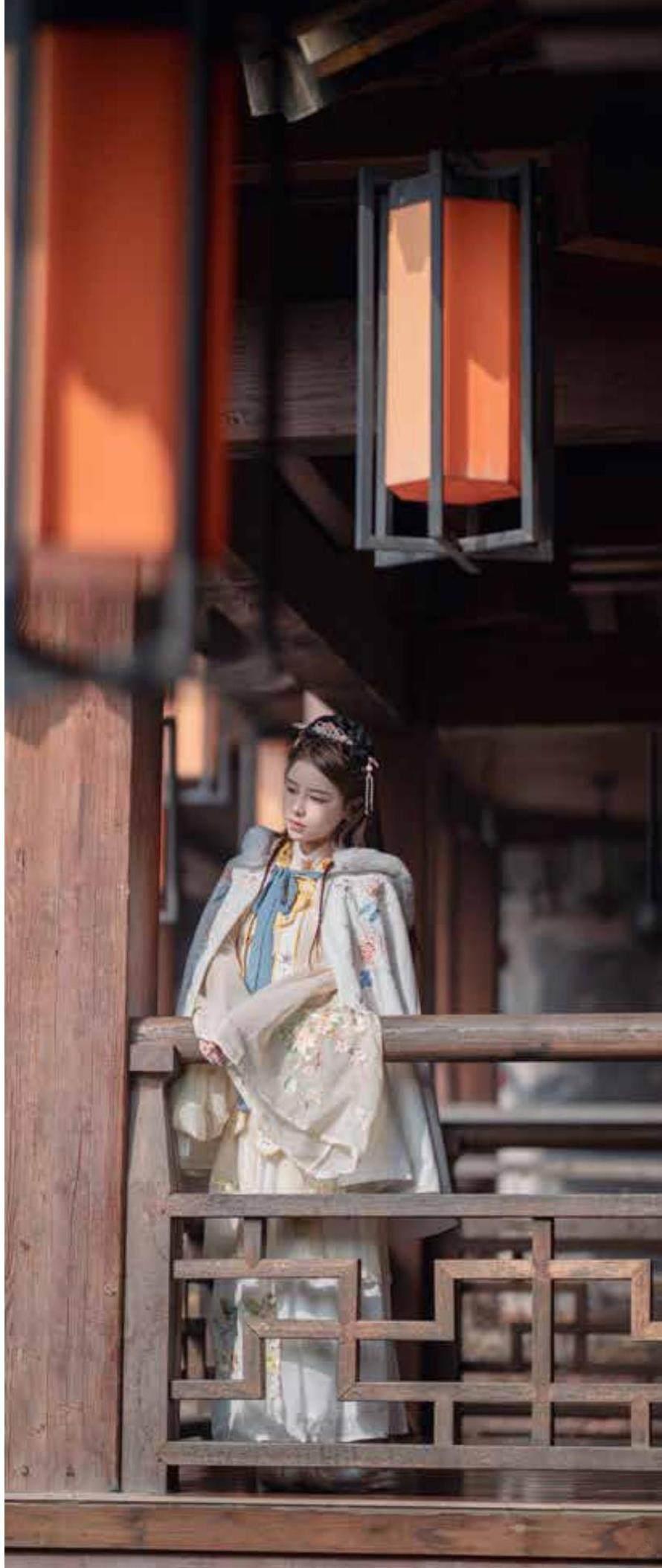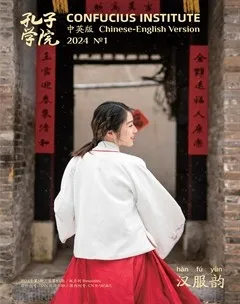“ 汉服热”:传统服饰文化与新机遇 Hanfu Craze: The Fusion of Tradition and Business
2024-03-04凡小亚FanXiaoya
凡小亚 Fan Xiaoya



春日田園,桃花灼灼。一位身着汉服、宛若天仙的女子款款走来,桃花酿酒,春水煮茶,别有天地在人间。李子柒的这段视频一经播出,众多国人便惊呼宜室宜家的古代女子穿越了,就连很多不懂中文的外国人也对视频中女子的服饰赞叹不已。这位古风汉服女神在不经意间令中国传统汉服优雅地展现在世界面前,同时也把中国的传统服饰文化带向了世界。
In the springtime countryside, peach blossomsare in full bloom. A graceful lady, adorned in Hanfuattire reminiscent of a celestial being, takes a leisurelystroll. Brewing wine from peach blossoms andsteeping tea in spring water, she creates a realmthat feels otherworldly within our earthlyexistence. When this video featuring Li Ziqiwas released, it left a deep impressionon many Chinese viewers, who feltas though an ancient woman haddescended into modern life. Eventhose who didn’t understandChinese couldn’t help but appreciatethe elegance of her clothing. ThisHanfu enthusiast effortlesslyshowcased China’s Hanfu tothe world and brought China’straditional clothing culture to aglobal audience.
何谓“ 汉服”? 汉服又称“ 衣冠”“衣裳”“汉装”,在汉语言文献中有两层含义:一是指中国历史上汉朝的服装;二是指能代表中国服饰的华夏族、汉民族服装。汉服爱好者则将汉服定义为从三皇五帝到明朝的汉民族传统服饰。一套完整的汉服通常由领、襟、衽(rèn)、衿、裾、袖、袂、带、韨等十部分组成。其中,汉服的领子最典型的特点是“交领右衽”。礼服讲究褒衣博带,常服讲究短衣宽袖。尽管款式繁多,但根据整体结构,汉服主要分为深衣制(上下相连)和上衣下裳制(两截穿衣)。“上衣下裳,天地阴阳”,汉服既象征法则和秩序,也体现了“天人合一、阴阳协调”的思想。除了衣服,汉服还包括由首服、发式、面饰、鞋履、配饰等共同组合的整体衣冠系统。其中,男子的常见头饰有冠、冕、幞(fú)头等,腰间佩玉;女子的常见头饰有簪子、发钗、步摇、珠花、金钿(diàn)等,配以香囊。
What is “Hanfu”? Also known as “Yiguan,”“Yishang,” and “Hanzhuang,” Hanfu holds dualsignificance in the Chinese language and culture.Firstly, it refers to the clothing worn during the HanDynasty in Chinese history. Secondly, it representsthe traditional attire of Huaxia, or the Han Chineseethnic group. Enthusiasts of Hanfu typically defineit as the traditional clothing worn by the Han ethnicgroup, spanning from the era of the Three Sovereignsand Five Emperors to the Ming Dynasty. A completeset of Hanfu consists of ten components,which include the collar, lapel, collarband, front panel, long skirt,cuffs, sleeves, sash, and fronthem. One distinctive featureof the Hanfu collar is that itsleft side covers the right sideand extends to the wearer’sright waist. Ceremonialattire emphasizes oversizedrobes and thick belts, whileeveryday wear tends to besimpler, featuring shortjackets and wide sleeves.While there is a wide varietyof s tyl e s , Hanfu can bebroadly categorized into “onepiecerobes” (where the topand the bottom are connected)and “separate upper and lowergarment s” ( c ons i s t ing of twodistinct pieces). The latter style not onlyrepresents “heaven and earth” and “rules andorder” but also embodies the “harmony betweenheaven and humanity and balance between Yin andYang.” In addition to clothing, Hanfu encompassesa comprehensive system of headwear, hairstyles,facial adornments, footwear, and accessories. Mencommonly wear crowns, caps, and head cloth asheadwear, often complemented by jade accessoriesaround their waist. Women frequently adornthemselves with hairpins, hair clasps, danglinghair clips, flower accessories, and gold hairpins,accompanied by scented sachets.
“國潮风”的兴起掀起了一股“汉服热”。生活中,我们常能看到身着汉服、配以妆容和发饰的年轻面孔。他们或锦衣华裳,灵动飘逸;或典雅清新,长风玉立。在购物平台搜索汉服店铺,我们发现,竟然有近一半出自山东小县城——曹县。那么,曹县汉服是如何火遍全网并成功“出圈”的呢?让我们一起走进曹县,追寻这座号称“宇宙中心”的“汉服之城”背后的文化故事。
The Hanfu Craze is fueled by the growinginterest in Chinese national fashion. In our dailylives, we frequently encounter young individualsdressed in Hanfu, complete with meticulously styledmakeup and hair accessories. They exude elegance,while others embody a fresh aura. A search for Hanfuretailers on online shopping platforms reveals thatnearly half of them originate from Cao County,a modest county in Shandong Province. Howdid Hanfu from there rise to become an internetsensation and make its mark in mainstream fashion?Come with us on a journey to explore the culturalstory of this “Hanfu town,” the epicenter of the Hanfuuniverse.
在汉服产业发展起来之前,曹县的工业基础薄弱,交通落后,农民不得不外出打工补贴家用,曹县大集镇丁楼村的任庆生曾经也是外出打工“大军”中的一员。
Before the Hanfu industry took off, Cao Countygrappled with a weak industrial base, limitedtransportation infrastructure, and a population offarmers who sought job opportunities elsewhere tosupport their families. Ren Qingsheng, a resident ofDinglou Village in Cao County, was among thosewho ventured outside for work.
2009年10月,任庆生和妻子决定开淘宝店,成为全村第一个“吃螃蟹”的人。一连好几个月,店铺都没什么生意,任庆生很是心焦。直到2010年4月,店铺才迎来第一位客户。这单生意虽然没赚到太多钱,却给了任庆生很大的信心。第一桶金也启发他将经营重点放在演出服售卖上,当年,他在淘宝销售演出服赚到了七八千元。那个年代,这在农村可以说是一笔“巨款”了。村民们都羡慕不已,纷纷向他“取经”,学习致富之道。丁楼村的网店数量飞速增加,逐渐成为中国有名的“淘宝村”。2019年,中国电商发展十周年之际,丁楼村的演出服和汉服销售额达到近5亿元。当年全国评选出十大创业人物,任庆生位列其中。如今,丁楼村生产的演出服,占全国市场的73%左右,汉服销售量占全国的43%左右,而且已经销往东南亚的十几个国家。
In October 2009, Ren and his wife made a bolddecision to open a store on Taobao, becoming thefirst in their village to do so. For several months,their store struggled to attract any customers, leavingRen anxious. It wasn’t until April 2010 that hewelcomed their very first customer. While this initialtransaction didn’t bring in substantial revenue, itgave him profound confidence. This modest successprompted him to focus on selling performancecostumes, and in that year, he earned between sevento eight thousand RMB on Taobao. In a rural setting,this was considered a substantial income. Villagersadmired his success and eagerly sought his guidanceand the secrets of prosperity. The number of onlinestores in Dinglou surged, eventually earning it thereputation of a “Taobao Village” in China. In 2019,commemorating the 10th anniversary of China’se-commerce development, the village’s sales ofperformance costumes and Hanfu soared to nearly500 million RMB. Ren was recognized as one ofthe top ten entrepreneurs in the country. Today,the performance costumes produced in his villagecommand a remarkable 73% market share nationwide,while Hanfu sales contribute approximately 43% tothe national total. Furthermore, these products arenow exported to over a dozen countries in SoutheastAsia.
2021年是丁楼村生意非常红火的一年。旺季的时候,每天的发单量在20 万单左右,一单甚至多达500 件。
The year 2021 witnessed an extraordinary boomfor Dinglou. During peak seasons, approximately200,000 orders were processed per day, with someorders exceeding 500 items each.
为何汉服会有如此大的市场呢?首先,中国的古装剧和仙侠剧带动了年轻人等对汉服的热爱。同时,汉服是一款“有门槛”的消费品,消费者既要有闲,又要有文化品位,其背后蕴藏着消费者对文化与审美、品位与生活的看法。此外,汉服还有极大的选择空间,既有物美价廉的平价汉服,也有精致华美的高端汉服。在购物平台搜索“高端汉服”,你會发现价格都在几千元甚至上万元。强烈的市场需求,反过来激发了曹县人新的创业热情,大家纷纷投身于原创汉服研究设计之中。他们参考学习各种相关文献和书籍,不断提升自己的专业知识,常耗费数月设计制作一套精美的汉服。曹县人的这种发奋图强、精益求精的态度,也得到了市场的良好反馈。安蔡楼镇戚永设计制作的一套高端定制汉服,竟然卖出了3.5万元的高价。
Why is the Hanfu marketflourishing? Firstly, a significantpar t of i t s success can beattributed to the influence ofChinese historical dramas andmartial arts fantasy shows, whichhave ignited a deep passion forHanfu among the young people. Moreover, Hanfucaters to a niche market, appealing to those withleisure time and a refined cultural taste. It servesas an avenue for people to express their culturalperspectives, aesthetics, tastes, and lifestyles.Moreover, the world of Hanfu offers a broadspectrum of choices, including affordable massmarketoptions and exquisite high-end ones. If yousearch for “high-end Hanfu” on shopping platforms,you’ll discover prices ranging from thousands to eventens of thousands of RMB. This strong demand hassparked a new wave of entrepreneurial spirit in CaoCounty, with many individuals venturing intooriginal Hanfu design. These designers consultrelevant literature and books, continuouslyenhancing their professional knowledgeand dedicating several months to crafting one set ofexquisite Hanfu. Their commitment to perfection hasearned them favorable responses in the market. Notably,a custom-made Hanfu designed by Qi Yong fromAncailou Town fetched an impressive 35,000 RMB.
从“村里没路灯,错落遍土方”到高楼大厦鳞次栉比,曹县的飞速发展也吸引了不少高学历人才回乡创业。他们运用最新的发展理念和经营方式,努力将汉服产业做大做强,从原料设计到加工销售,形成了一条完整的汉服产业链。如今,在各大电商平台都能找到曹县汉服的身影。2014年,还在读书的胡春青回到曹县大集镇胡楼村走亲访友,他发现村里不少年轻人靠做电商售卖演出服走上了致富之路,于是决定注册自己的淘宝店。此后,胡春青的妻子孟晓霞也回到胡楼村,全职打理网店,胡春青则边读书边做线上销售,二人的网店年均销售额达70 多万元。
From a village with “few streetlights andscattered earth mounds” to one dominated bytowering skyscrapers on its skyline, the rapiddevelopment of Cao County has attracted educatedindividuals to return to their roots and startbusinesses. These people are applying cuttingedgeconcepts and practices to expand the Hanfuindustry and have built a comprehensive supplychain, covering everything from raw materialdesign to manufacturing and sales. As a result,the county’s Hanfu products are now featured onvarious e-commerce platforms. One notable storyinvolves Hu Chunqing. While still a student in 2014,he returned to his hometown, Hulou Village in DajiTown, to visit friends and family. During his visit, heobserved that many young villagers were thriving byselling performance costumes online. Inspired, hedecided to open his own Taobao store. Soon after,Hu’s wife, Meng Xiaoxia, returned to the village tomanage the store full-time. Hu, on the other hand,divided his time between his studies and onlinesales. Together, their store generates an annualrevenue exceeding 700,000 RMB.
2018年,胡春青博士毕业。他回到家乡,正式开启创业之路。夫妻俩的网店生意蒸蒸日上,还开启了网上直播。2022年,在胡春青的大力推动下,曹县汉服协会成立,汉服行业从无序竞争转向良性发展。在此之后,他又有了新的想法,他认为不同形式的汉服产品应该差异化发展:“有的做唐朝齐胸襦裙,有的做宋代女子襦裙,有的做明朝进士巾袍……每个商家都找准一个赛道,精心耕耘,总会各有收获。”胡春青还成立了自己的工作室——胡博士汉服工作室,以此来宣传汉服文化。
In 2018, after obtaining his doctoral degree,Hu returned to his hometown and ventured intoentrepreneurship. The couple’s online store businessthrived, and they even started online live streaming.By 2022, under Hu’s leadership, the Cao CountyHanfu Association was founded, bringing order tothe industry that had previously been marked byintense competition. Building on this success, Huintroduced a fresh approach, emphasizing the needfor diverse products: “Some may specialize in TangDynasty attire, some in Song Dynasty clothing,and others in Ming Dynasty scholar robes... Eachmerchant should identify their unique niche andnurture it carefully for success.” He also establishedhis venture, Dr. Hu’s Studio, to promote Hanfuculture.
据统计,2019 年,bilibili网站上的汉服爱好者多达8 347 万人,其中83% 为24 岁以下的年轻人。2021 年,汉服爱好者的数量新增689.4万人,市场销售额达101.6亿元。2023年,微博中“汉服”话题的阅读量已达75.8亿次,讨论量达643.3万次;抖音里的“汉服”话题播放量达857.9亿次,与汉服有关的用户还在逐年增加。从中式婚礼的火热到汉服的爆单;从故宫文创的走红到中国街拍、中国元素的流行,汉服不仅仅是一种服饰,更是中国“礼仪之邦”“锦绣中华”的体现,它承载了中国的染织绣等杰出工艺和美学,传承了30多项中国非物质文化遗产。汉服文化,早已超越美学、礼仪、艺术、制度等形式文化范畴。“汉服热”的背后,是中華优秀传统文化的魅力,也是当代年轻人对中国传统服饰文化的热爱与传承。
According to statistics, in 2019, bilibili had aremarkable 83.47 million Hanfu enthusiasts, with animpressive 83% of them being individuals under theage of 24. In 2021, the number of Hanfu enthusiastsincreased by 6.894 million, driving sales to animpressive 10.16 billion RMB. In 2023 alone, Hanfuhas amassed 7.58 billion reads and 6.433 milliondiscussions on Weibo. Meanwhile, on Douyin, Hanfuhas garnered 85.79 billion views, accompanied bya consistent rise in Hanfu-related user engagementyear after year. From the resurgence of traditionalChinese weddings to the surging demand for Hanfu,and from the thriving creative cultural productsof the Palace Museum to the rise of Chinese streetfashion and popular culture, Hanfu goes beyondmere fashion. It serves as an embodiment of China’srich heritage in etiquette and the magnificenceof Chinese culture. Hanfu not only showcasesexceptional Chinese craftsmanship and aesthetics indyeing, weaving and embroidery, but also safeguardsover 30 elements of China’s intangible culturalheritage. Hanfu culture transcends aesthetics, rites,art, and institutional boundaries. At the core of the“Hanfu Craze” lies the allure of China’s traditionalculture, as well as the dedication of today’s younggeneration to preserving and passing on the legacy oftraditional Chinese clothing.
